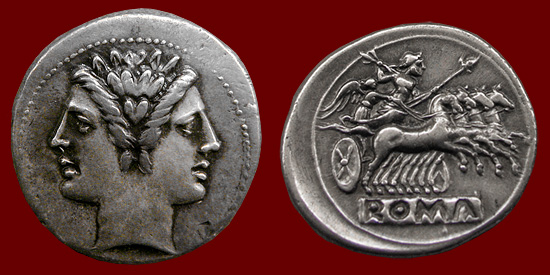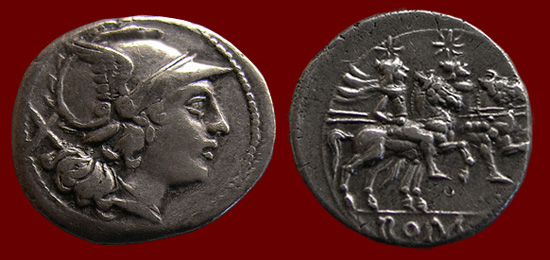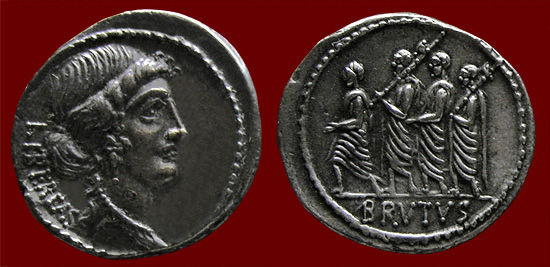
During the third century BCE, designs on silver coins included only a few standard types that referred to traditional Roman themes. For example, silver coins issued after the victory over Carthage in the First Punic War all bore on the obverse the head of the two-faced god Janus to celebrate the closing of his shrine that marked the end of the war in 241 BCE, and on the reverse Jupiter hurling a thunderbolt from a chariot driven by Victory (because of this design the coin was called “quadrigatus,” meaning “four-horsed”):

During the Second Punic War against Hannibal, the Romans suffered financial as well as military losses, and around 211 BCE the state began a major recoinage, producing silver denarii whose weight was half that of the older quadrigati. These new silver coins also had a standard design, with the helmeted head of the goddess Roma on the obverse and on the reverse the Dioscuri (the twins Castor and Pollux, who according to the legendary history of early Rome had given the Romans victory in the Battle of Lake Regillus) mounted on horseback. Because of its design and lighter weight, the Romans nicknamed this coin “bigatus,” meaning “two-horsed”:

By the mid-second century BCE, the mint magistrates, who were young men from elite families at the beginning of their careers, were adding their names to the coins and advertising their ancestral families. For example, about 97 BCE the moneyer L. Pomponius Molo issued a denarius with the head of Apollo and his own name L. POMPON. MOLO on the obverse and on the reverse a depiction of the legendary Roman king Numa Pompilius performing a sacrifice (this family claimed to be descended from Numa):

This sort of self-promotion greatly intensified during the second half of the first century BCE and frequently became overtly political. For example, in 55 BCE, the moneyer Q. Pomponius Rufus issued an unusual double-tailed coin depicting the curule chairs of his two grandfathers, who had held a joint consulship in 88 BCE:

The following year, the moneyer M. Junius Brutus issued a denarius with the head of the goddess Libertas on the obverse and on the reverse his alleged ancestor Lucius Junius Brutus, who according to legend had helped to overthrow the Tarquin kings and found the Roman Republic. This coin was an eerie prediction of events to come, since just 10 years later Brutus would be among the assassins of Julius Caesar:
